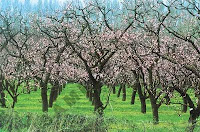A two minute walk up a slight ridge overlooking the train tracks led to combination post office and store. We asked for directions to the house and discovered that we would have to walk the three miles to it since no one living in the area owned an auto. The only phone available was the one in the little store and taxis were non existent. There was no town as such, only a cluster of several houses near a church.
About a quarter mile down the road, we passed a large gate of tall iron spikes guarding a chateau that seemed closed and unused. As we left the populated area near the railroad tracks, the road traversed flat, agricultural fields. The dry, soft dirt of the road made little puffs of dust over our shoes as we walked along.
 Eventually we saw a house in the distance that turned out to be the one we came to see. Opposite the house were two more houses, one with a locked gate and shuttered windows. Later we learned it was owned by a stock broker in Paris whose wife and children used it during school vacations. The house next door to it was owned and lived in by a middle aged couple who farmed various plots of land in the surrounding area.
Eventually we saw a house in the distance that turned out to be the one we came to see. Opposite the house were two more houses, one with a locked gate and shuttered windows. Later we learned it was owned by a stock broker in Paris whose wife and children used it during school vacations. The house next door to it was owned and lived in by a middle aged couple who farmed various plots of land in the surrounding area.A path thru a small field took us to the caretaker of the property, an old woman who walked back to the house with us and answered our questions.
It had a well for drinking water, but no plumbing for running water; however it was wired for electricity with incandescent bulbs hanging from ceiling cords. The kitchen had a brick wall stove and oven and a small 2 burner stove like the kerosene stove we used back in Palo Alto at Stanford Village. A bedroom with a huge wooden shutter for a window was entered from the kitchen. When the shutter was open, one could step over the 2 foot high sill to enter or leave the room without walking through the kitchen door which was the only door into the house. There was a pseudo bathroom with a toilet one flushed with a bucket of water.
Thru a door two steps up from the kitchen was a large room with a stairway along one wall leading to a large up stairs room with two large wooden shutters. One opened to a view of a cherry orchard, the other opened to green fields with a creek running thru it. Outside on the back side of the house was a door leading to a dirt floor cellar where cider and wine casks were stored.
 There were several apple trees near the kitchen door and about 15 cherry trees stretching to the far end of the property. Because the grounds gradually sloped toward a line of trees growing along the edge of a creek, we had a view over looking the fields in the far distance.
There were several apple trees near the kitchen door and about 15 cherry trees stretching to the far end of the property. Because the grounds gradually sloped toward a line of trees growing along the edge of a creek, we had a view over looking the fields in the far distance. The old woman told us propane could be gotten to run the little 2 burner stove but one would have to push a wheel barrow to and from the post office /store for the tank. There would not be anyone to help since all the farmers were busy in the fields.
My husband and I must have been thinking the same thing during the tour. When we looked at each other, we knew we had found a home in the country. It was a perfect place for artists to live and work. The limitations only added to the romance of our experience. We paid the caretaker the agreed amount of money and received the key.
Thus began the second year of our stay in France.
[Editor's Note: Marangis is now associated with the town of Vernou-La-Celle-Sur-Seine.]
The following links are in french and have references to Marangis:
- Google Map: Marangis 77670
- ViaMichelin Map: Marangis 77670
- French Wiki: Vernou-la-Celle-sur-Seine
- Official Site: Vernou-la-Celle-sur-Seine
- French Wiki: History of the Valley of 7 Mills (Marangis is one of them)
Here are some other period photos of that area.




1 comment:
Je l'aime quand ma maman écrit au sujet de la France! Il y a des poteaux de téléphone dans l'image mais il n'y avait AUCUN poteau de téléphone quand elle était là!
[I love it when my Mom writes about France. There are telephone poles in the picture but there were NO telephone poles when she was there!]
Kim
Post a Comment